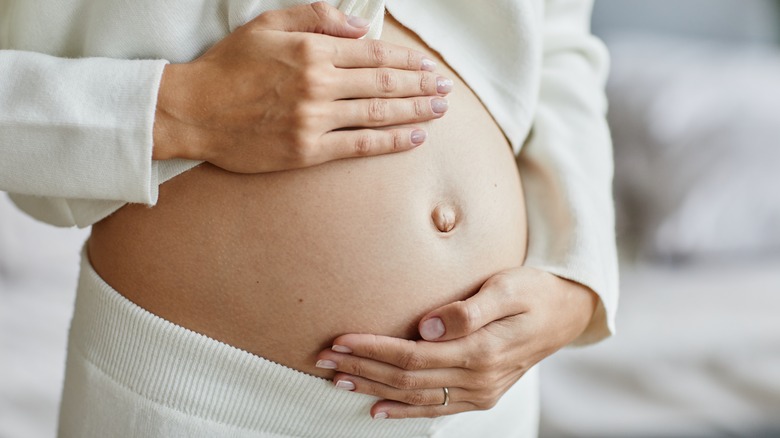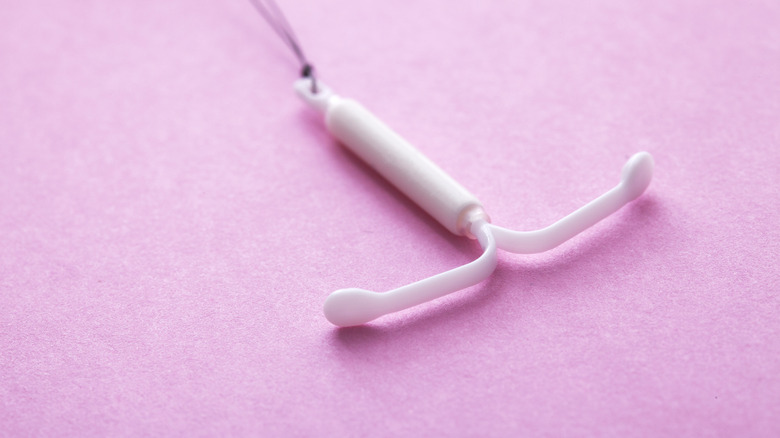How Quickly Can You Get Pregnant After IUD Removal?
The intrauterine device, or IUD, has long been proven to be one of the most effective forms of birth control. Categorized as a Long-Acting Reversible Contraceptive (LARC), many women choose to have IUDs installed in their bodies as they require very little maintenance. "A LARC's main advantage is 'set it and forget it,'" Samantha M. Dunham, MD, clinical associate professor in the department of obstetrics and gynecology at NYU Langone Health, told Glamour. "It may require more effort to start up, but requires less effort over time."
Dr. Sarita Sonalkar, an assistant professor of obstetrics and gynecology at the Perelman School of Medicine at the University of Pennsylvania, also told The New York Times they're preferred by people because of the variety of options available. There are hormonal IUDs that work to prevent the sperm from ever being in contact with the egg and copper IUDs that function as spermicides. Whichever you end up choosing, once you have the T-shaped device situated in your uterus, you're looking at around three to 12 years of continuous contraception.
You can also choose to have it removed at any time you want. And according to experts, you can get pregnant almost immediately after the IUD is out of your system.
It's possible to get pregnant as soon as you have the IUD taken out
First things first, Dr. Selina Sandoval, a complex family planning expert, told Parents that there's no need for an IUD removal unless "you are hoping or willing to get pregnant." If your goal for removal is to conceive, it apparently doesn't take long to get pregnant. Dr. Jessica Scotchie, a board-certified OB-GYN and co-founder of Tennessee Reproductive Medicine, shared with Healthline that you can try to conceive in the first month after you remove the IUD.
With that being said, the odds of conceiving a child may still depend on your age. Scotchie notes that if you're under 35, you have roughly a 20% chance of conceiving per month, which increases to 60 in 6 months and 85 to 90% in a year. Your chances then decrease as you age.
Sandoval added that the odds of pregnancy could also be contingent on your lifestyle, health, and more. "The process to get pregnant will be different for everyone," she continued. Moreover, Dr. Banafsheh Kashani, an OB-GYN, explained to Forbes that if you're not in a hurry to conceive, you may want to wait two to three months before attempting. "This is to allow your body to resume its normal (or ovulatory) menstrual cycles and allows you time to take prenatal vitamins, stop smoking, minimize drinking and caffeine, and make healthy lifestyle choices," she said.
What to know before removing your IUD
Unlike the insertion of IUDs which many people report to be incredibly uncomfortable, the removal is less of a hassle, said Dr. Amy Roskin, an OB-GYN and chief medical officer of birth control delivery service Favor. "Beyond some mild spotting and temporary cramps, there should be minimal discomfort as a result of the procedure," she shared with Forbes.
There's also no downtime or lengthy recovery process involved, but medical experts always suggest giving yourself some good 'ol me-time. "It can be a luxury to take time to care for ourselves, but it should be a serious part of the process," Leigh Senderowicz, a health disparities research scholar at the University of Wisconsin School of Medicine and Public Health, shared with Good Housekeeping. "An IUD is a medical device that's being inserted and removed — to the extent that you can, give your mind and body ample time and space to recover."
Plus, if you are concerned about your ability to conceive after removal, it's always wise to consult your doctor. "Anyone with irregular cycles, heavy, painful menses, or who has been trying to conceive for 12 months without success (if under 35 years old) or six months without success (if over 35 years old) should see a physician," Dr. Jessica Scotchie noted.


